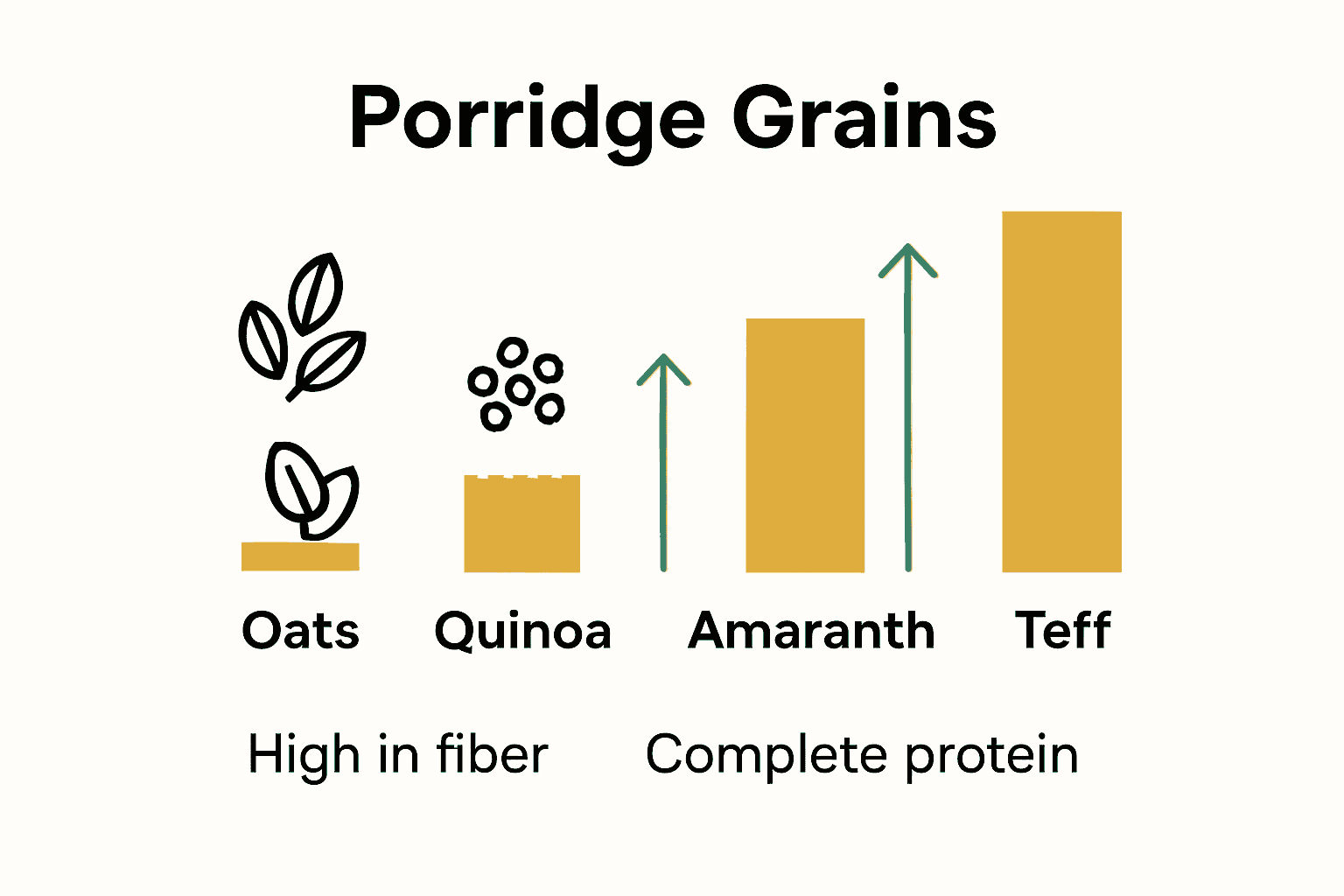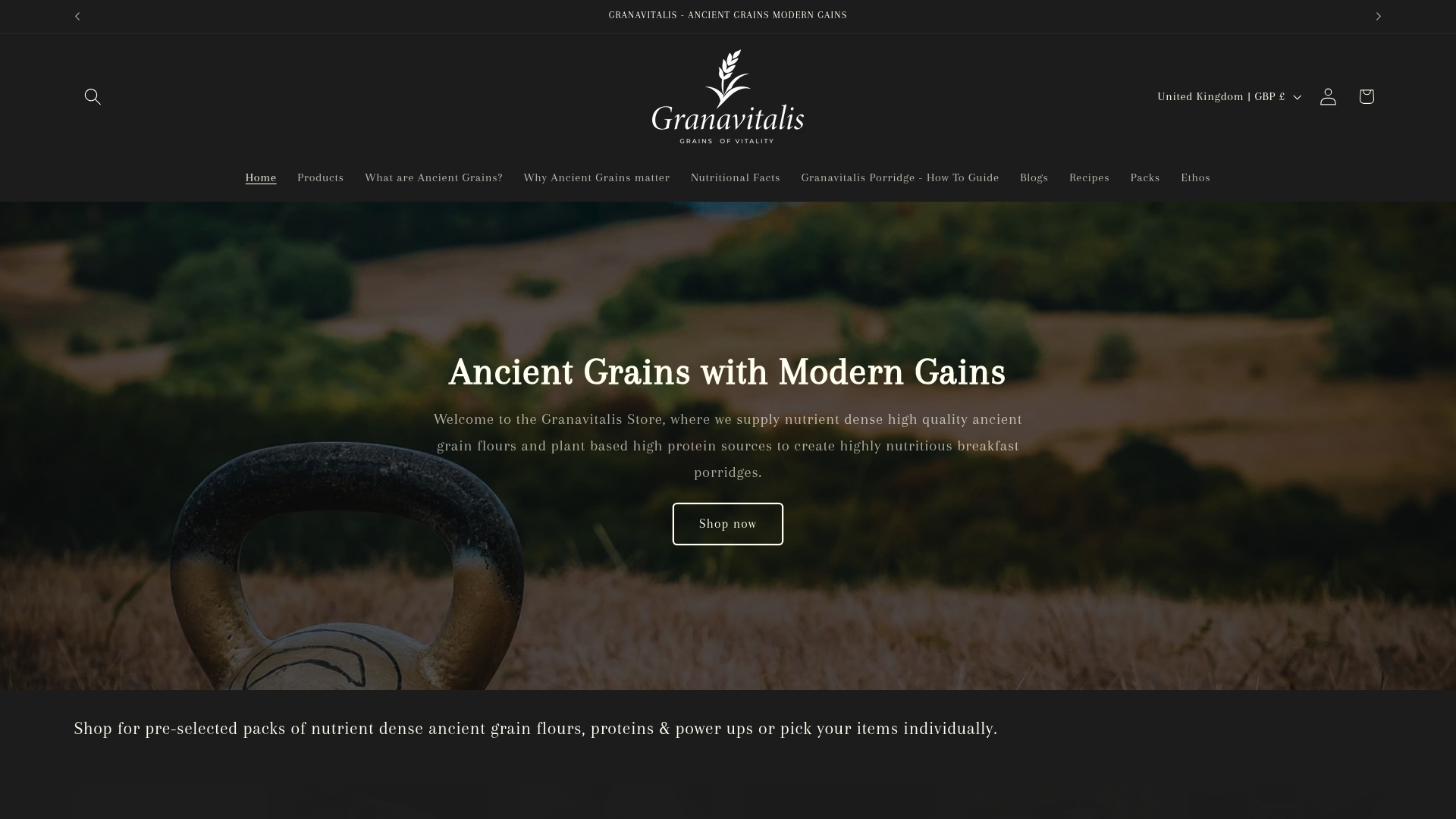
Protein-Packed Porridge Guide: Create Nourishing Breakfasts
Share
Did you know that a breakfast made with ancient grains can deliver up to 30 percent more protein compared to traditional oats? Making the shift to nutrient-rich grains and quality protein options supports stronger muscles, better energy, and steady focus throughout the day. Discover the simple adjustments that turn your morning porridge into a true nutritional powerhouse for lasting satisfaction and taste.
Table of Contents
- Step 1: Select Nutrient-Rich Ancient Grains And Quality Proteins
- Step 2: Prepare Ingredients For Optimal Flavour And Nutrition
- Step 3: Cook Porridge For The Perfect Creamy Consistency
- Step 4: Boost Nutrition With Wholesome Toppings And Mix-Ins
- Step 5: Check Texture And Taste For A Protein-Packed Finish
Quick Summary
| Key Point | Explanation |
|---|---|
| 1. Select nutrient-dense ancient grains | Choose grains like quinoa, amaranth, and teff for complete proteins and micronutrients that enhance breakfast nutrition. |
| 2. Layer ingredients for optimal nutrition | Begin with a base of ancient grains, then add protein and nutrient-rich fruits to create a balanced meal. |
| 3. Cook with precision for creaminess | Use a heavy-bottomed pan, stir frequently, and adjust liquid for the desired porridge consistency. |
| 4. Enhance with nutritious toppings | Add low-fat yoghurt, nuts, seeds, and fruit to boost protein and health benefits while enhancing flavor. |
| 5. Taste and adjust for satisfaction | Ensure porridge has a creamy texture; let it rest after cooking for the best flavor and consistency. |
Step 1: Select nutrient-rich ancient grains and quality proteins
Choosing the right base for your protein-packed porridge starts with understanding how nutrient-dense ancient grains can transform your breakfast from a basic meal into a powerhouse of nutrition. According to the NHS Eatwell Guide, incorporating a variety of whole grains ensures balanced nutrition that supports overall health and energy levels.
When selecting your ancient grains, look for options like quinoa, amaranth, teff, and kamut which offer exceptional protein profiles and micronutrient density. These grains provide complete proteins with all essential amino acids your body needs.
 Consider mixing different grains to create a more complex nutritional profile and interesting texture. For protein supplementation, explore high quality plant based options like pea protein powder, hemp protein, or nut protein powders which blend seamlessly into porridge and boost overall protein content.
Consider mixing different grains to create a more complex nutritional profile and interesting texture. For protein supplementation, explore high quality plant based options like pea protein powder, hemp protein, or nut protein powders which blend seamlessly into porridge and boost overall protein content.
A helpful tip when building your protein porridge is to layer your nutrition strategically. Start with a base of ancient grains, add your protein powder, and then enhance the meal with nutrient-rich fruits recommended by the NHS to contribute to your daily recommended fruit intake. This approach ensures you are creating a balanced meal that supports sustained energy and optimal morning nutrition.
Step 2: Prepare ingredients for optimal flavour and nutrition
Preparing a protein-packed porridge requires thoughtful ingredient selection and preparation to maximize both nutrition and taste. Learn how to create delicious high protein porridge by understanding the art of ingredient combination and technique.
According to the NHS recipes, combining porridge oats with milk and water provides an excellent base for a nutritious breakfast. To enhance flavour and nutrition, consider adding fresh or mashed fruits like bananas and raspberries. Begin by measuring your chosen ancient grains and protein powder precisely to maintain consistent nutritional balance. Pre soaking grains can help improve digestibility and reduce cooking time while maintaining their nutrient profile.

A helpful preparation tip is to create versatile ingredient combinations. For instance, try mixing quinoa with hemp protein and topping with seasonal berries or using amaranth with pea protein and sliced almonds. Experimenting with different combinations ensures you never get bored while maintaining a nutrient dense breakfast. As recommended by the NHS overnight oats recipe, you can even prepare your porridge the night before by mixing ingredients and refrigerating to save time in the morning.
Step 3: Cook porridge for the perfect creamy consistency
Cooking porridge requires precision and attention to create a luxuriously smooth breakfast that nourishes both body and palate. Learn how to make gluten free porridge to ensure your technique works for various dietary needs.
According to NHS recipes, heating porridge oats with milk and water while stirring constantly is key to achieving a thick and creamy consistency. Start by selecting a heavy bottomed saucepan to distribute heat evenly and prevent burning. Use a ratio of one part grains to two parts liquid for optimal texture. Begin cooking over medium heat and stir continuously to prevent clumping and ensure even cooking. The stirring process helps break down starches and create a smoother texture.
A pro tip for achieving the perfect porridge is to adjust liquid quantities based on your preferred consistency. For a thicker porridge, reduce liquid slightly or cook for a few extra minutes. For a lighter texture, add more liquid or remove from heat sooner. As recommended by the NHS three bears breakfast recipe, simmering and stirring often helps create a smooth and creamy texture that will transform your morning meal from ordinary to extraordinary.
Step 4: Boost nutrition with wholesome toppings and mix-ins
Transforming your protein porridge from basic to extraordinary happens through strategic and thoughtful toppings that amplify both nutrition and flavour. Discover high protein porridge grains to complement your topping selections and create a truly remarkable breakfast experience.
According to NHS recommendations, topping porridge with low-fat natural yoghurt, apple slices, and raspberries significantly enhances nutritional value and taste. Consider creating layers of nutrition by adding protein-rich mix-ins like chopped nuts, seeds, nut butters, and plant-based protein powders. These additions not only increase protein content but also introduce diverse textures and flavour profiles that make your morning meal more interesting.
A helpful strategy is to think about balanced nutrition with each topping choice. Fresh berries provide antioxidants, nuts offer healthy fats, seeds contribute minerals, and yoghurt adds probiotics. As the NHS overnight oats recipe suggests, incorporating low-fat natural yoghurt and fresh or frozen berries can dramatically increase your breakfast’s nutritional density. Experiment with combinations like chia seeds with almond butter, or pumpkin seeds with coconut flakes to keep your porridge exciting and nutritionally complete.
Step 5: Check texture and taste for a protein-packed finish
The final moment of creating your perfect protein porridge is all about achieving that sublime balance of texture, flavour, and nutritional satisfaction. Explore vegan protein sources to enhance your porridge game and understand the nuanced art of protein-rich breakfast creation.
According to NHS recipes, ensuring the porridge is thickened and simmered properly results in a satisfying texture and taste. Start by assessing the consistency look for a creamy yet not overly dense mixture that holds its shape but still flows slightly when spooned. Taste test your porridge and adjust seasoning with a pinch of salt or a drizzle of honey to enhance the overall flavour profile. The goal is to create a breakfast that feels indulgent while remaining nutritionally powerful.
A pro tip for perfecting your protein porridge is to let it rest for a minute or two after cooking. As recommended by the NHS three bears breakfast recipe, adjusting the consistency through careful simmering and stirring helps achieve the ultimate creamy texture. This resting period allows the grains to absorb any remaining liquid and settle into a more harmonious consistency. Remember that protein porridge is a living dish it can be adjusted with a splash of milk or a few extra stirs to reach your ideal texture.
Elevate Your Breakfast with Nutrient-Rich Protein Porridge
Struggling to find wholesome breakfast options that truly fuel your mornings and keep you energised until lunch The challenge many face is balancing rich nutrition with great taste and convenience. This guide highlights how combining ancient grains and high-quality proteins can transform your porridge into a nourishing powerhouse packed with essential micronutrients and sustaining energy. It addresses the common goal of avoiding quick-fix cereals that spike blood sugar but leave you hungry and tired.
At Granavitalis, we understand the importance of starting your day with a meal that supports well-being and resilience. Explore our range of Vegan Protein Powders to boost your porridge with pure plant-based protein sources designed for optimal health. Our Metabolic Advantage Pack blends premium ancient grains and nutrition power ups to create balanced breakfasts that energise and nourish.

Begin transforming your breakfast routine today by visiting Granavitalis and discover how our ancestral ingredients can help you craft delicious protein-packed porridge effortlessly. Do not wait to give your body the balanced nutrition it deserves for sustained energy and vitality every morning.
Frequently Asked Questions
What ancient grains are best for protein-packed porridge?
Choosing quinoa, amaranth, teff, and kamut can give your porridge an excellent protein boost and micronutrient density. Start by selecting one or more of these grains as your base to enhance the nutritional profile of your breakfast.
How can I prepare my protein porridge to improve its flavor?
Enhance the flavor of your protein porridge by adding ingredients like fresh fruits, spices, or low-fat yogurt. Experiment with combinations such as bananas and nut butter or berries and almond slices to create a delicious and nutritious meal.
What is the ideal cooking ratio for making creamy porridge?
A good cooking ratio for porridge is one part ancient grains to two parts liquid. Maintain this ratio while stirring constantly over medium heat to achieve a creamy consistency that is smooth and satisfying.
How can I incorporate toppings to boost nutrition in my porridge?
Boost nutrition by adding a variety of toppings like nuts, seeds, and fresh fruits to your porridge. Aim for a mix of textures and flavors; for example, sprinkle chia seeds and top with apple slices for added nutrients and taste.
What should I do if my porridge is too thick or too runny?
Adjust the consistency of your porridge by adding extra liquid if it’s too thick or cooking a bit longer if it’s too runny. A simple method is to add a splash of milk or water and stir until you reach your desired texture.
How can I ensure my protein porridge is nutritious and satisfying?
To make your protein porridge both nutritious and satisfying, focus on a balance of grains, protein powders, and toppings. Regularly incorporate different ingredients to keep meals varied, such as rotating between different fruits, nuts, and spices.
Recommended
- How to Make High-Protein Porridge: A Nutritious Start – Granavitalis
- 7 High-Protein Porridge Grains to Power Your Morning – Granavitalis
- Complete Guide to High Protein Porridge – Granavitalis
- How to Add More Protein to Porridge Naturally – Granavitalis
- 8 Healthy Snacks for Pregnancy You Should Try – Fit Stockings
